home > products
> BAT's
>
BAT
examples
> example A.3.b
Recording and mimicking the vocalization of bats using air-coupled BAT® transducers
Background:
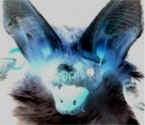 the ultrasonic vision
of bats -
Bats are nocturnal mammals with poor
eyesight who have evolved highly-sophisticated echolocation systems based
on air-coupled ultrasound. Such echolocation systems are a form of ultrasonic vision
that allow the bats to "see" without the use
of light. Over 700 species of echo-locating bat exist and most feed
themselves by locating and capturing insects in flight using
ultrasonic techniques. Bats create and hear sound in much the
same way as humans, namely using a larynx and vocal tract for
transmission, and ears and an auditory system for reception. However,
there are two significant differences: (i) bat vocalization and hearing
occurs at much higher frequencies than our own; and (ii) bats probably
concern themselves more with assembling spatial information from returning
echoes than with bi-directional communication of ideas.
the ultrasonic vision
of bats -
Bats are nocturnal mammals with poor
eyesight who have evolved highly-sophisticated echolocation systems based
on air-coupled ultrasound. Such echolocation systems are a form of ultrasonic vision
that allow the bats to "see" without the use
of light. Over 700 species of echo-locating bat exist and most feed
themselves by locating and capturing insects in flight using
ultrasonic techniques. Bats create and hear sound in much the
same way as humans, namely using a larynx and vocal tract for
transmission, and ears and an auditory system for reception. However,
there are two significant differences: (i) bat vocalization and hearing
occurs at much higher frequencies than our own; and (ii) bats probably
concern themselves more with assembling spatial information from returning
echoes than with bi-directional communication of ideas.
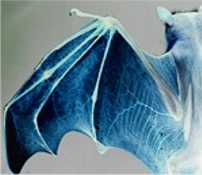 even
to bats bandwidth matters - Because sophisticated
tasks like navigation and hunting would not be possible with narrow band
ultrasonic frequency responses, bats have naturally evolved with broadband
ultrasonic systems. They typically employ a frequency-swept chirp-mode of operation
in which both amplitude- and frequency- modulation are
used during vocalization and subsequent neural processing. A typical bat
in flight emits short (~2msec long) bursts of frequency-swept
ultrasound at regular intervals of ~100msec. By analyzing returning echoes
for frequency content and time-of-flight, the bat is then able to
determine the location and nature of objects in its immediate surroundings
(at distances of up to 5-10 meters away). If any object of interest is
detected, the bat increases both its pulse repetition rate and its
ultrasonic chirp bandwidth while decreasing the duration of each chirp, so
as to obtain more detailed information from the ultrasonic echoes. If an
object happens to be a flying insect (e.g., a moth) the bat can
determine from returning echoes both the insects' shape and wing-flutter
frequency and so determine if it is a favourite snack. If deemed edible, the
bat will initiate a final sequence of events known as the
"pursuit manoeuvre" so as to secure the meal.
even
to bats bandwidth matters - Because sophisticated
tasks like navigation and hunting would not be possible with narrow band
ultrasonic frequency responses, bats have naturally evolved with broadband
ultrasonic systems. They typically employ a frequency-swept chirp-mode of operation
in which both amplitude- and frequency- modulation are
used during vocalization and subsequent neural processing. A typical bat
in flight emits short (~2msec long) bursts of frequency-swept
ultrasound at regular intervals of ~100msec. By analyzing returning echoes
for frequency content and time-of-flight, the bat is then able to
determine the location and nature of objects in its immediate surroundings
(at distances of up to 5-10 meters away). If any object of interest is
detected, the bat increases both its pulse repetition rate and its
ultrasonic chirp bandwidth while decreasing the duration of each chirp, so
as to obtain more detailed information from the ultrasonic echoes. If an
object happens to be a flying insect (e.g., a moth) the bat can
determine from returning echoes both the insects' shape and wing-flutter
frequency and so determine if it is a favourite snack. If deemed edible, the
bat will initiate a final sequence of events known as the
"pursuit manoeuvre" so as to secure the meal.
Experiment #1: (detecting vocalizations)
MicroAcoustic's
BAT™ transducers can be used to detect the ultrasonic
vocalizations of bats. In this example, typical vocalizations of two
different bats of the same species (Eptesicus.fuscus) were detected using
MicroAcoustic's BAT-1
transducer.
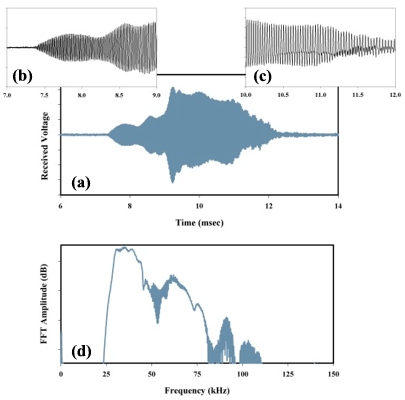
results for
bat #1... A typical received waveform for the first bat is shown
above (signal-a) and is seen to be a complicated amplitude-
modulated chirp of approximately 5msec total duration. Expanding the
beginning and end sections of signal-a (to create signals b
and c respectively) shows more clearly the frequency modulation
that also occurs in the vocalization from its beginning to its end. The
overall frequency content in the vocalization is shown in figure-d,
as obtained from a Fast-Fourier Transform (or FFT). Figure-d
indicates that most of the energy in the vocalization falls within the
frequency band from 25-50kHz, though energy is present all the way up to
~110kHz. Compared to the measured emissions from katydids
by BAT™ transducers, the vocalization of bat#1 is seen to be of
significantly broader bandwidth.
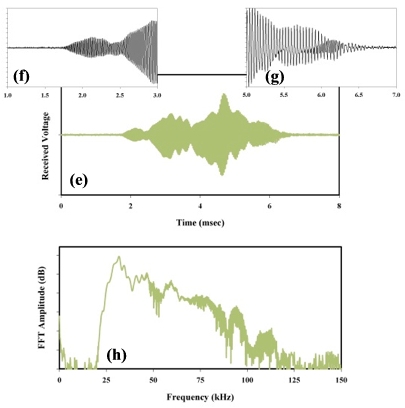
results for bat #2... The second bat studied was from the same species as the first, and its vocalization is shown above (green) in the same format. Immediately obvious from a comparison of signal-e (bat #2) with signal-a (bat #1), is the individual nature of bat voices. Though the two vocalizations are of similar temporal length and spectral response, the amplitude modulation employed by each bat is quite different. This is not unlike our own human voices, where individual differences are always present though the general nature remains the same.
Experiment #2: (mimicking vocalizations)
The MicroAcoustic BAT™ can alternatively be used to mimic the vocalizations of bats. To demonstrate this, the vocalization of bat#1 (signal-a above) was reproduced and converted into a drive voltage using an arbitrary function generator and broadband power amplifier before being reapplied to a MicroAcoustic BAT™ source (model BAT-1). The ultrasound generated by the BAT™ source was then detected by a second BAT™ detector. The results are displayed in the waveforms i through l below, where similarities with the actual emission of bat#1 above are obvious. Particularly convincing is the spectral plot (figure-l), which bears striking resemblance to the actual frequency response of bat#1 (figure-d). Indeed, it could be said that the Micro Acoustic BAT™ has mimicked the vocalization of bat#1 better than a second bat of its own species (i.e., bat#2).
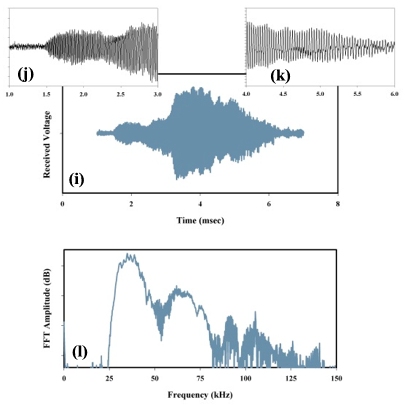
Conclusions:
1) These measurements show that MicroAcoustic's BAT® detectors can be employed to accurately record and study the ultrasonic emissions of actual bats. Because emitted sound pressure levels of bats are similar to those of other ultrasonic animals, the results also show that BAT® detectors will be of general use in the study of animal & insect bio-acoustic emissions.
2) Unlike available microphone technologies which are limited to frequencies below ~135kHz, the MicroAcoustic BAT® detectors have a much higher bandwidth (i.e., greater than 2MHz). This means that by employing a BAT® detector instead you will be certain to capture ALL information present in your studies of bats and not overlook what may be present (though as yet undiscovered) at higher frequencies.
3) MicroAcoustic's BAT® transducers can be used as sources to reproduce (or mimic) the actual emissions of ultrasonic animals. This opens up new potential avenues for systematic behavioural research, in which BAT® sources are employed to mimic a wide variety of animal emissions under repeatable control of the experimenter.
<< previous example ~ next example >>
*Note: The experimental results presented here were obtained by D.W. Schindel during his tenure at the NRC Institute for Aerospace Research. Contribution and reproduction of these results and figures occurs courtesy of the NRC Institute for Aerospace Research, Canada.
www.microacoustic.com